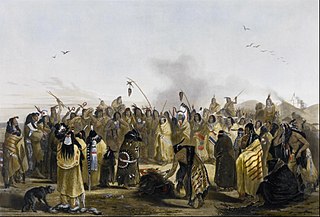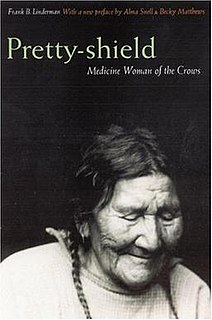Further reading
- Bataille, Gretchen M.; Laurie, Lisa, eds. (2003). Native American Women: A Biographical Dictionary. Routledge. p. 312. ISBN 978-1-135-95587-8 . Retrieved 1 May 2020.
The Other Magpie was a Crow woman best known for fighting in the Battle of the Rosebud on the side of General George Crook against the Sioux and Cheyenne, alongside Osh-Tisch. [1]
Pretty Shield, a Crow author and medicine woman, described her as being wild and attractive, but not having a man. [1] She fought for revenge against the Sioux who had killed her brother. Most of the Crow carried rifles, but The Other Magpie carried only her belt knife and her coup stick. [2] She counted coup on a Sioux warrior and eventually killed and scalped him. The scalp that she took was one of only eleven taken in the battle. [3] Shield described her as having tied a feather on the end of her coup stick to symbolize her achievement. Later, she cut the scalp into pieces and gave them to the male warriors so they would have more scalps for the dance after the battle. [4] An alternative report has The Other Magpie take part in the dance herself. [5]

The Crow, whose autonym is Apsáalooke, also spelled Absaroka, are Native Americans living primarily in southern Montana. Today, the Crow people have a federally recognized tribe, the Crow Tribe of Montana, with an Indian reservation located in the south-central part of the state.

The Battle of the Little Bighorn, known to the Lakota and other Plains Indians as the Battle of the Greasy Grass and also commonly referred to as Custer's Last Stand, was an armed engagement between combined forces of the Lakota Sioux, Northern Cheyenne, and Arapaho tribes and the 7th Cavalry Regiment of the United States Army. The battle, which resulted in the defeat of U.S. forces, was the most significant action of the Great Sioux War of 1876. It took place on June 25–26, 1876, along the Little Bighorn River in the Crow Indian Reservation in southeastern Montana Territory.

Sitting Bull was a Hunkpapa Lakota leader who led his people during years of resistance against United States government policies. He was killed by Indian agency police on the Standing Rock Indian Reservation during an attempt to arrest him, at a time when authorities feared that he would join the Ghost Dance movement.

Red Cloud's War was an armed conflict between an alliance of the Lakota, Northern Cheyenne, and Northern Arapaho peoples and the United States that took place in the Wyoming and Montana territories from 1866 to 1868. The war was fought over control of the western Powder River Country in present north-central Wyoming. This grassland, rich in buffalo, was traditionally Crow Indian land, but the Lakota had recently taken control. The Crow tribe held the treaty right to the disputed area, according to the major agreement reached at Fort Laramie in 1851. All involved in "Red Cloud's War" were parties in that treaty.

Scalping is the act of cutting or tearing a part of the human scalp, with hair attached, from the head, and generally occurred in warfare with the scalp being a trophy. Scalp-taking is considered part of the broader cultural practice of the taking and display of human body parts as trophies, and may have developed as an alternative to the taking of human heads, for scalps were easier to take, transport, and preserve for subsequent display. Scalping independently developed in various cultures in both the Old and New Worlds.

Crazy Horse was a Lakota war leader of the Oglala band in the 19th century. He took up arms against the United States federal government to fight against encroachment by white American settlers on Native American territory and to preserve the traditional way of life of the Lakota people. His participation in several famous battles of the Black Hills War on the northern Great Plains, among them the Fetterman Fight in 1866, in which he acted as a decoy, and the Battle of the Little Bighorn in 1876, in which he led a war party to victory, earned him great respect from both his enemies and his own people.

Plenty Coups was the principal chief of the Crow Nation ("Apsáalooke") and a visionary leader.

The Sioux Wars were a series of conflicts between the United States and various subgroups of the Sioux people which occurred in the later half of the 19th century. The earliest conflict came in 1854 when a fight broke out at Fort Laramie in Wyoming, when Sioux warriors killed 31 American soldiers in the Grattan Massacre, and the final came in 1890 during the Ghost Dance War.

Goes Ahead was a Crow scout for George Armstrong Custer’s 7th Cavalry during the 1876 campaign against the Sioux and Northern Cheyenne. He was a survivor of the Battle of the Little Big Horn, and his accounts of the battle are valued by modern historians.

Bloody Knife was an American Indian who served as a scout and guide for the U.S. 7th Cavalry Regiment. He was the favorite scout of Lieutenant Colonel George Armstrong Custer and has been called "perhaps the most famous Native American scout to serve the U.S. Army."

Among the Plains Indians of North America, counting coup is the warrior tradition of winning prestige against an enemy in battle. It is one of the traditional ways of showing bravery in the face of an enemy and involves intimidating him, and, it is hoped, persuading him to admit defeat, without having to kill him. These victories may then be remembered, recorded, and recounted as part of the community's oral, written, or pictorial histories.
One Who Walks With the Stars was an Oglala Lakota woman who fought against General Custer's men at Big Horn.

Moving Robe Woman, also known as Mary Crawler, Her Eagle Robe, She Walks With Her Shawl, Walking Blanket Woman, Moves Robe Woman, Walks With Her Robe and Tashenamani was a Hunkpapa Sioux woman who fought against General George Custer during the Battle of Little Big Horn to avenge her brother, One Hawk, who had been killed.

Running Eagle (Pi'tamaka) was a Native American woman and war chief of the Blackfeet Tribe known for her success in battle.

Pretty Shield (1856–1944) was a medicine woman of the Crow Nation. Her biography, perhaps the first record of female Native American life, was written by Frank B. Linderman, who interviewed her using an interpreter and sign language.
Osh-Tisch was a Crow badé. A badé is a male-bodied person in a Crow community who takes part in some of the social and ceremonial roles usually filled by women in that culture.

The Little People of the Pryor Mountains are a race of ferocious dwarves in the folklore of the Crow Nation, a Native American tribe. The Little People were also seen as imparting spiritual wisdom, and played a major role in shaping the destiny of the Crow People through the dreams of the iconic Crow chief, Plenty Coups.

White Swan (c.1850—1904), or Mee-nah-tsee-us in the Crow language, was one of six Crow Scouts for George Armstrong Custer's 7th Cavalry Regiment during the 1876 campaign against the Sioux and Northern Cheyenne. At the Battle of the Little Bighorn in the Crow Indian Reservation, White Swan went with Major Reno's detachment, and fought alongside the soldiers at the south end of the village. Of the six Crow scouts at the Battle of the Little Bighorn, White Swan stands out because he aggressively sought combat with multiple Sioux and Cheyenne warriors, and he was the only Crow Scout to be wounded in action, suffering severe wounds to his hand/wrist and leg/foot. After being disabled by his wounds, he was taken to Reno's hill entrenchments by Half Yellow Face, the pipe-bearer (leader) of the Crow scouts, which no doubt saved his life.
The Tongue River massacre was an attack by Cheyenne and Lakota on a camp of Crow people in 1820. According to some accounts, it was one of the most significant losses of the Crow tribe.
During the American Indian Wars of the mid to late 19th century, Native American warriors of the Great Plains, sometimes referred to as Braves in contemporary colonial sources, resisted Westward expansion onto their ancestral land by the settlers of the United States. Though a diverse range of peoples inhabited the Great Plains, there were a number of commonalities among their warfare practices.